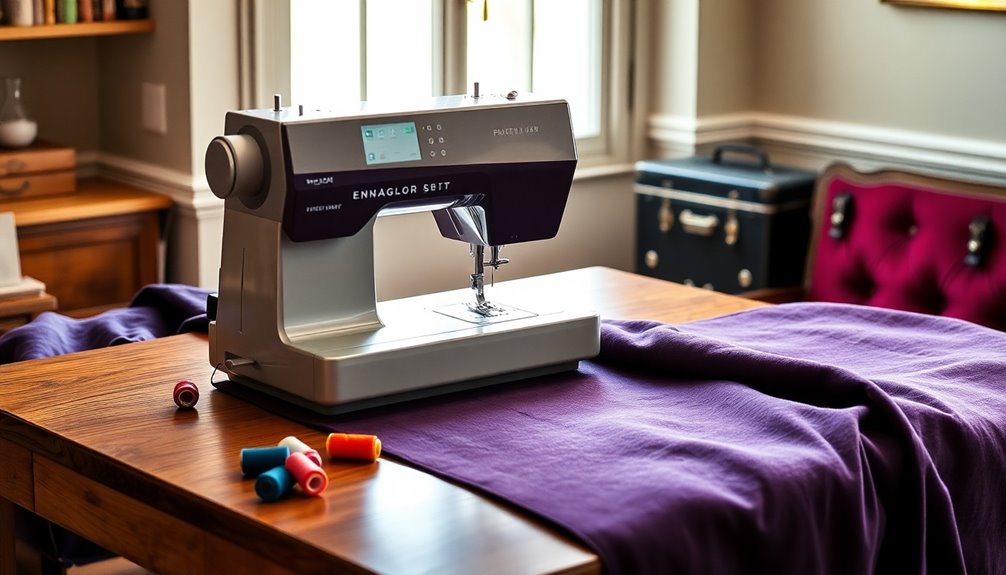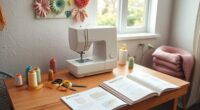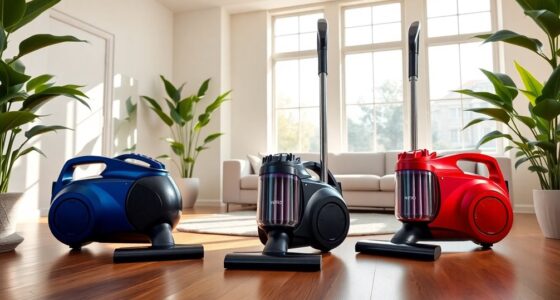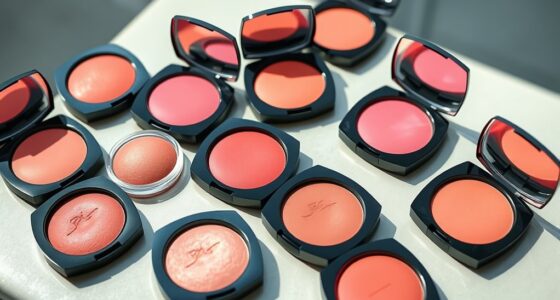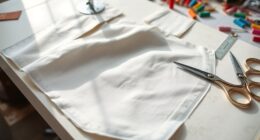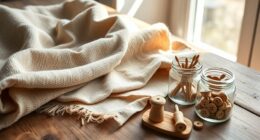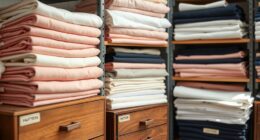If you’re looking for the best sewing machines for upholstery and home repairs, I’ve got you covered! From the versatile SINGER Quantum Stylist 9960 to the powerful SINGER Heavy Duty 500 Classic, there’s a perfect fit for every project. Don’t overlook the handy Brother XM2701 for beginners or the durable PLANTIONAL Sewing Kit. I’ll break down key factors and features that matter so you can make an informed choice for your sewing tasks. Stick around to discover more! When choosing the best sewing machines for home use, it’s essential to consider your specific needs, such as the types of fabrics you’ll be working with and the projects you plan to tackle. Features like stitch variety, ease of use, and durability can significantly impact your sewing experience. Whether you’re a beginner or an experienced seamstress, finding the right machine can elevate your skills and inspire creativity in your upholstery and home repair projects.
Key Takeaways
- Look for machines with a strong motor, like the SINGER Heavy Duty series, to handle heavy fabrics effectively.
- Consider models with a variety of built-in stitches, such as the SINGER Quantum Stylist 9960, for versatile sewing projects.
- Ensure the sewing machine features a durable metal frame for stability during high-speed sewing on thick materials.
- User-friendly features like automatic needle threaders and clear instructions enhance the experience for both beginners and experienced sewists.
- Regular maintenance, including cleaning and using the appropriate needles, is crucial for optimal performance and longevity of sewing machines.
SINGER Quantum Stylist 9960 Computerized Sewing & Quilting Machine
If you're looking for a sewing machine that combines versatility and ease of use, the SINGER Quantum Stylist 9960 is a fantastic choice. With 600 built-in stitches and 1,172 stitch applications, it handles everything from essential to decorative stitches effortlessly. The automatic needle threader and thread cutter save me so much time. I particularly love the adjustable sewing speed and the extension table, which makes working on large projects like quilts a breeze. Plus, it's user-friendly for both beginners and seasoned sewists. I've found it reliable, quiet, and perfect for all my upholstery and home repair needs.
Best For: The SINGER Quantum Stylist 9960 is best for both beginners and experienced sewists looking for a versatile and reliable sewing machine for a variety of projects.
Pros:
- 600 built-in stitches and 1,172 stitch applications offer a wide range of creative possibilities for various sewing tasks.
- Automatic needle threader and thread cutter save time and enhance the sewing experience by reducing manual effort.
- Extension table provides ample workspace for larger projects, making it ideal for quilting and upholstery work.
Cons:
- Some users may find the machine a bit heavy and less portable due to its solid construction.
- The learning curve for navigating all features and settings may be challenging for complete beginners.
- A few users have reported that the machine can be sensitive to incorrect threading, requiring careful setup.
SINGER Heavy Duty 500 Classic Sewing Machine
The SINGER Heavy Duty 500 Classic Sewing Machine stands out for those who tackle upholstery projects or home repairs, thanks to its powerful motor that delivers 50% more strength than standard models. I love its vintage-inspired design that adds charm to my sewing space while offering modern features like a built-in needle threader and one-step buttonhole. The customizable stitch settings let me adjust lengths and widths for various fabrics, ensuring precision. With a full metal frame, it feels stable during high-speed sewing. Although there's a slight learning curve, its performance is reliable and quiet, making it a great choice for any sewing enthusiast.
Best For: The SINGER Heavy Duty 500 Classic Sewing Machine is best for sewing enthusiasts who work with heavy fabrics and appreciate a blend of vintage aesthetics and modern functionality.
Pros:
- Powerful motor provides 50% more strength than standard models, making it ideal for heavy fabrics like denim and canvas.
- Customizable stitch settings allow for precision tailoring of stitches for various fabric types and techniques.
- Durable full metal frame ensures stability during high-speed sewing for reliable performance.
Cons:
- Some components, such as the presser foot lever, are plastic, which may raise concerns about overall quality.
- Users may experience a learning curve with threading and bobbin winding, impacting initial usability.
- The lack of a printed manual may pose challenges, although an online version is available for reference.
Brother XM2701 Sewing Machine
For those looking to plunge into sewing without feeling overwhelmed, the Brother XM2701 Sewing Machine stands out as an ideal choice. It's lightweight and packed with features, including 27 built-in stitches for various projects. The automatic needle threader and jam-resistant bobbin make setup a breeze, while the free arm is perfect for cuffs and sleeves. I appreciate the instructional DVD and clear threading guides that make it user-friendly for both beginners and seasoned sewists. Plus, with a 25-year warranty and stellar customer support, I feel confident in my investment. Overall, this machine inspires creativity and helps tackle home repairs effortlessly!
Best For: Beginners and intermediate sewists looking for a lightweight, user-friendly machine with versatile stitching options.
Pros:
- User-friendly design with automatic needle threading and clear instructions, making it easy for beginners to get started.
- Lightweight and portable, allowing for easy transport to classes or sewing groups.
- Versatile features including 27 built-in stitches and multiple sewing feet that cater to various sewing projects.
Cons:
- May struggle with heavier fabrics like denim, limiting its use for more advanced projects.
- The limited warranty of 25 years may not cover all potential issues over time.
- Intended for US use only, which may restrict international buyers from utilizing the product without voiding the warranty.
PLANTIONAL Upholstery Repair Sewing Kit (47 Pieces)
Crafted with versatility in mind, the PLANTIONAL Upholstery Repair Sewing Kit is ideal for anyone tackling upholstery projects or home repairs. With 47 heavy-duty pieces, including 32 leather sewing needles and 10 durable threads in various colors, this kit meets a range of needs. I love how it includes practical tools such as scissors and a seam ripper, all organized in a compact case. Whether you're mending car seats or repairing tents, this kit is perfect for both beginners and pros. Rated 4.7 stars by users, it's a handy companion for quick fixes around the house or on the go.
Best For: The PLANTIONAL Upholstery Repair Sewing Kit is best for DIY enthusiasts, professionals in leathercraft, and anyone needing quick repair solutions for upholstery and other household items.
Pros:
- Versatile: Suitable for a wide range of repairs, from furniture to clothing.
- Comprehensive Kit: Contains 47 pieces, including various needles and practical tools for effective sewing.
- Highly Rated: Enjoys a 4.7-star rating, indicating strong customer satisfaction and ease of use.
Cons:
- Thread Strength: Some users have reported concerns about the thread's strength for heavy-duty tasks.
- Limited Heavy-Duty Application: May not be ideal for extremely tough materials or repairs requiring industrial-grade tools.
- Learning Curve: Beginners may need some time to get accustomed to using all the different tools effectively.
SINGER Heavy Duty 4432 Sewing Machine with Accessory Kit
If you're tackling upholstery projects and home repairs, the SINGER Heavy Duty 4432 Sewing Machine is a game-changer. With its heavy-duty metal frame and ability to sew up to 1,100 stitches per minute, it handles everything from delicate silks to thick denim effortlessly. I love the user-friendly features like the top drop-in bobbin and built-in reverse lever for reinforcing stitches. Plus, the StayBright LED lighting makes it easy to see my work. This machine is perfect for both beginners and experienced sewers, and I can't recommend it enough for anyone serious about their sewing projects!
Best For: The SINGER Heavy Duty 4432 Sewing Machine is best for both beginners and experienced sewers who are looking for a reliable and efficient machine for various sewing projects, including upholstery and home repairs.
Pros:
- Heavy-duty metal frame ensures stability and durability for long-lasting use.
- High sewing speed of up to 1,100 stitches per minute allows for quick completion of projects.
- User-friendly features such as the top drop-in bobbin and built-in reverse lever enhance convenience and ease of use.
Cons:
- Limited advanced features may not satisfy very experienced sewers looking for more complex options.
- Heavier weight may make it less portable compared to lighter models.
- Initial learning curve for absolute beginners who may need time to get accustomed to the machine's functions.
Handheld Mini Portable Electric Sewing Machine
Looking for a quick solution to your sewing emergencies? The Handheld Mini Portable Electric Sewing Machine is a game changer! Weighing just 10.5 ounces, this compact machine fits perfectly in your travel bag. You can power it with 4 AA batteries or a DC adapter, making it super versatile. It's user-friendly, great for various fabrics like jeans, T-shirts, and curtains. Plus, it comes with a complete toolkit, so you can start sewing right away. With a stellar 4.8-star rating, it's an ideal choice for beginners and a practical gift for anyone who loves DIY projects.
Best For: Those seeking a lightweight, portable sewing solution for quick repairs and DIY projects, especially beginners and children.
Pros:
- Compact and lightweight design makes it easy to carry and store, ideal for travel.
- Versatile fabric compatibility allows for sewing a variety of materials, from clothing to home decor.
- Complete toolkit included, ensuring users have everything they need to start sewing immediately.
Cons:
- Power options require batteries or a separate adapter, which are not included with the purchase.
- Limited power compared to full-sized machines, may struggle with thicker fabrics.
- Not as durable as traditional sewing machines, potentially limiting long-term use for heavy projects.
Topus Upholstery Repair Sewing Thread Kit
For anyone tackling upholstery projects or home repairs, the Topus Extra Strong Upholstery Repair Sewing Thread Kit stands out with its robust 3-ply nylon thread that's perfect for heavy-duty sewing tasks. I love that it includes seven styles of heavy-duty curved needles and three rolls of 70-yard nylon thread in different colors. This kit performs exceptionally well with thick fabrics like leather, canvas, and upholstery. Customers rave about its sturdiness, giving it an impressive 4.5-star rating. Just remember to handle the sharp needles carefully and adjust your stitch length for the best results. It's truly a must-have for serious sewing enthusiasts!
Best For: Upholstery enthusiasts and DIY home repairers looking for a reliable sewing kit suitable for heavy-duty fabrics.
Pros:
- Durable: Made with bonded 3-ply nylon thread for enhanced strength and longevity.
- Versatile: Includes various needle styles, making it suitable for a wide range of materials including leather and canvas.
- Highly Rated: Customers appreciate its effectiveness, reflected in a solid 4.5-star rating from over 2,300 reviews.
Cons:
- Sharp Needles: Requires careful handling to prevent injuries, especially around children.
- Limited Colors: The kit only includes three colors of thread, which may not suit every project.
- Stitch Adjustment Needed: Optimal performance may require users to adjust stitch length, which can be a learning curve for beginners.
Brother Computerized Sewing and Quilting Machine
The Brother Computerized Sewing and Quilting Machine stands out as an exceptional choice for those who crave versatility in their sewing projects. With 165 built-in stitches, including utility and decorative options, I found it incredibly easy to customize my creations. The automatic needle threader and jam-resistant bobbin make setup a breeze. I appreciate the intuitive LCD display, which simplifies selecting stitches. While the mini table extender can be cumbersome, the machine operates quietly and excels with various fabrics. Overall, I highly recommend this model for both beginners and seasoned sewers looking to enhance their creative possibilities.
Best For: The Brother Computerized Sewing and Quilting Machine is best for both beginners and experienced sewers seeking a versatile and user-friendly machine for various sewing projects.
Pros:
- Easy to use with extensive stitch variety catering to different sewing styles.
- Includes additional accessories and a protective hard cover for enhanced usability.
- Quiet operation and smooth performance across a range of fabrics.
Cons:
- The mini table extender can be cumbersome and less practical for larger projects.
- The auto sewing function may be less intuitive compared to traditional pedal operation.
- Horizontal thread placement can lead to thread mishaps, indicating a need for better design features.
Handheld Portable Mini Sewing Machine for Beginners
Perfect for beginners, the Handheld Portable Mini Sewing Machine offers an approachable design that makes sewing tasks a breeze. Weighing only 14.4 ounces and measuring just 8.86 x 4.72 x 2.54 inches, it's incredibly portable. I love its two-speed options—fast for quick fixes and slow for detailed work. The easy threading mechanism and adjustable needle height simplify the setup. It handles thick fabrics like denim effortlessly, making it ideal for repairs and DIY projects. Plus, the included accessories guarantee you're ready to sew right away. If you're new to sewing, this mini machine is a fantastic choice!
Best For: Beginners and casual users looking for a portable and easy-to-use sewing machine for basic tasks and quick repairs. With its user-friendly design and compact size, this sewing machine is ideal for those who want to tackle simple projects without the intimidation of complex features. It comes equipped with essential stitches and automatic settings, making it one of the best sewing machines for home use. Whether you’re hemming curtains or mending clothes, this machine will help you achieve professional results with minimal effort.
Pros:
- User-friendly design with simple instructions and colorful illustrated manual, perfect for novices.
- Lightweight and compact, making it easy to store and carry for on-the-go sewing projects.
- Versatile performance, effectively handling thick fabrics and various sewing needs with two speed options.
Cons:
- Limited functionality may not satisfy advanced sewers seeking extensive features.
- Struggles with complex sewing tasks, making it less suitable for intricate projects.
- Potential difficulty with very thick materials, which may exceed the machine's capabilities.
Mini Sewing Machine with Accessory Kit for Beginners
If you're a beginner looking to plunge into the world of sewing, the Mini Sewing Machine with Accessory Kit stands out as an ideal choice. It's lightweight and portable, making it perfect for home or travel. I love how it easily handles various fabrics, from clothing to leather. The manual control lets me sew precisely according to my preference, and the included accessories—like bobbins and needles—mean I can start right away. With a 5.0-star rating, it's clear others appreciate its ease of use and versatility. Just remember to handle the needle carefully and avoid thick fabrics!
Best For: Beginners and hobbyists looking for a lightweight, portable sewing solution for various fabric types.
Pros:
- Lightweight and portable design makes it convenient for travel and home use.
- Easy to use with manual control and clear instructions, perfect for beginners.
- Comes with essential accessories included, allowing users to start sewing immediately without extra purchases.
Cons:
- Limited to fabrics thinner than 1.8mm, which may restrict some projects.
- Sharp needle requires careful handling, posing a safety risk for inexperienced users.
- May lack the power and features of traditional desktop sewing machines for more advanced projects.
Rechargeable Handheld Sewing Machine for Beginners and Adults
Looking for a sewing solution that fits snugly in your hand? I've found that the rechargeable handheld sewing machine is perfect for both beginners and seasoned users. It's lightweight and compact, making it easy to take on the go. With adjustable speeds, I can tackle everything from light fabrics to heavier materials like denim. It runs on AA batteries or a power source, adding to its versatility. Plus, the included 37-piece accessory set covers all my needs, from quick repairs to DIY projects. It's ideal for everyday fixes—think popped buttons and hems—without the hassle of a full-sized machine.
Best For: Beginners and adults looking for a portable and easy-to-use sewing solution for everyday repairs and small projects.
Pros:
- Lightweight and Compact: Easy to carry and store, making it perfect for on-the-go sewing.
- Adjustable Speeds: Two speed options allow for efficient sewing on both light and heavy materials.
- Comprehensive Accessory Set: Comes with 37 accessories to enhance functionality for various sewing tasks.
Cons:
- Limited to Straight Stitching: Not suitable for complex sewing operations or intricate designs.
- Battery Not Included: Requires four AA batteries for cordless use, which are not provided.
- Not Designed for Heavy-Duty Tasks: Best for light repairs rather than heavy or extensive sewing projects.
IRONWALLS Leather Cobbler Manual Sewing Machine for Shoe Repair
The IRONWALLS Leather Cobbler Manual Sewing Machine stands out as an excellent choice for DIY enthusiasts and hobbyists who want to tackle shoe repairs and other leather projects at home. Its heavy-duty design can handle various materials like nylon and leather, making it versatile for different tasks. I appreciate the 360-degree rotating foot, which allows easy sewing around tall boots. While it requires self-assembly and some adjustments for peak performance, online resources can guide beginners. Just keep in mind the initial learning curve, and you'll find this machine a valuable addition to your toolkit for home repairs.
Best For: DIY enthusiasts and hobbyists looking for an affordable solution for shoe and leather repairs at home.
Pros:
- Durable construction with tough iron and aluminum alloy ensures long-lasting use.
- Versatile sewing capabilities for various materials, including leather, nylon, and rubber.
- The 360-degree rotating foot allows for easy maneuverability around tall boots and complex shapes.
Cons:
- Requires self-assembly and may need adjustments for optimal performance.
- Users may encounter missing components and quality control issues, such as rust.
- The learning curve can be steep for beginners, necessitating additional resources for setup and troubleshooting.
Cobbler Sewing Machine for Leather and Fabrics
Crafted specifically for leather enthusiasts and home repair aficionados, the 2021 Cobbler Sewing Machine stands out with its robust 250W motor, allowing you to tackle projects requiring significant stitching power. Its stainless steel base and optimized design enhance smooth operation, though assembly can be tricky due to mismatched bolt holes and unclear instructions. I've found that it handles thick materials well, but you'll need to be patient with motor control. Regular maintenance is essential to prevent rust, and having the right needle sizes on hand makes a difference. Overall, it's a solid choice if you're prepared for a bit of a learning curve.
Best For: Leather enthusiasts and home repair aficionados looking for a powerful sewing machine capable of handling thick materials.
Pros:
- Strong 250W motor allows for efficient sewing of thick leather and fabrics.
- Stainless steel base enhances durability and stability during operation.
- Effective for various materials when the right needle sizes are used.
Cons:
- Challenging assembly with mismatched bolt holes and inadequate instructions can frustrate users.
- High maintenance required to prevent rust and ensure smooth operation.
- Motor control issues can hinder precision sewing, particularly for beginners.
Handheld Sewing Machine for Beginners
If you're new to sewing and need a reliable tool for quick fixes or DIY projects, a handheld sewing machine is perfect for you. I recently tried the Ankuwa model, and I found it incredibly user-friendly. Weighing just 7.4 ounces, it's lightweight and easy to carry around, making it great for home or travel. It handles various fabrics, from denim to silk, and can tackle small sewing issues effortlessly. With 35 accessories included, I felt well-equipped. Plus, its quiet operation and simple threading instructions make it ideal for beginners. Trust me, this handy little machine is a fantastic choice to start your sewing journey!
Best For: beginners and casual sewers looking for a portable and easy-to-use sewing solution for quick repairs and DIY projects.
Pros:
- Lightweight and portable design makes it easy to carry for on-the-go sewing.
- Versatile fabric handling allows sewing on a variety of materials, including denim and silk.
- Includes 35 accessories to enhance the sewing experience and provide additional convenience.
Cons:
- Limited to one stitch type, which may not satisfy more advanced sewing needs.
- Powered by batteries, which can be inconvenient and may require frequent replacements.
- May struggle with thicker fabrics exceeding the 1.8mm thickness limit.
SINGER Heavy Duty 4452 Sewing Machine with Accessory Kit
For anyone tackling upholstery projects or home repairs, the SINGER Heavy Duty 4452 Sewing Machine stands out with its remarkable ability to sew through multiple layers of thick fabric. With a strong motor and a speed of 1,100 stitches per minute, it's a true workhorse. I love the 110 stitch applications, which allow for creative flexibility, and the automatic needle threader makes setup a breeze. The included accessory kit, featuring various presser feet, enhances versatility. While it performs excellently, I recommend regular cleaning and checking the spool pin to avoid thread jams. Overall, it's a fantastic choice for any sewist!
Best For: The SINGER Heavy Duty 4452 Sewing Machine is best for both beginners and experienced sewists looking for a reliable, versatile machine capable of handling thick fabrics and complex projects.
Pros:
- Powerful motor with high-speed stitching at 1,100 stitches per minute for efficient project completion.
- Wide range of 110 stitch applications for creative flexibility in various sewing projects.
- Comprehensive accessory kit included, enhancing versatility and ease of use.
Cons:
- Potential issues with the upright spool pin causing thread jams, requiring careful thread management.
- Requires regular cleaning and oiling to maintain optimal performance.
- Users should verify voltage compatibility when purchasing internationally to avoid issues.
Factors to Consider When Choosing a Sewing Machine for Upholstery and Home Repairs
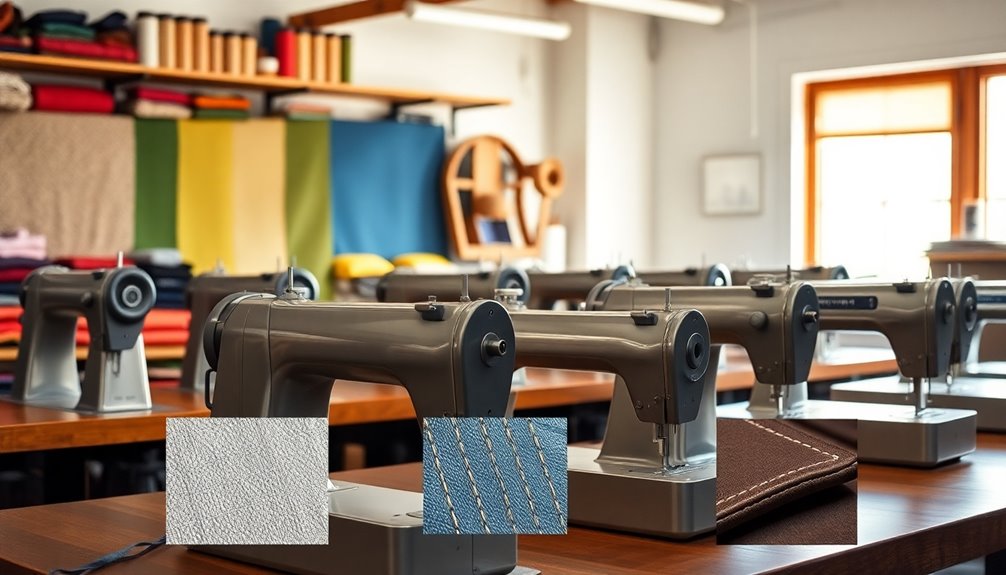
When I think about choosing a sewing machine for upholstery and home repairs, there are a few key factors that come to mind. Fabric compatibility, stitch variety, and motor power can really make a difference in how well the machine performs. Plus, I always consider durability, stability, and ease of use to guarantee I'm making the right investment.
Fabric Compatibility
Choosing the right sewing machine for upholstery and home repairs means considering fabric compatibility right from the start. I always recommend looking for a machine that can tackle heavy fabrics like denim, leather, and canvas. These materials need a robust motor and strong piercing power for effective stitching. Adjustable stitch length and width settings are essential, too, as they give you the flexibility for various upholstery projects. A top drop-in bobbin system with a clear view cover makes monitoring and replacing the bobbin easy. High sewing speeds over 1,000 stitches per minute can help you finish large projects faster. Finally, don't overlook specialized presser feet, like walking or non-stick feet, to manage multiple layers without shifting.
Stitch Variety
While selecting a sewing machine, I find that having a diverse range of stitch options is essential for tackling various upholstery and home repair projects. A machine with basic, stretch, and decorative stitches offers the versatility I need to adapt to different tasks. Automatic buttonhole features simplify creating professional finishes for cushions. Plus, customizing stitch length and width helps me work with various fabric types, ensuring I achieve the best results. Built-in lettering fonts allow me to personalize my projects, adding a unique touch to home decor. Additionally, having access to different presser feet, like walking feet for multiple layers and zipper feet for installations, greatly enhances my sewing experience and improves the outcomes of my projects.
Motor Power
Motor power plays a pivotal role in my decision-making process when selecting a sewing machine for upholstery and home repairs. I've found that machines with higher motor power are essential for handling heavy fabrics, like upholstery and denim. Typically, these motors offer about 50% more power than standard ones, allowing me to sew through multiple layers without jamming. I appreciate machines capable of sewing up to 1,100 stitches per minute, as this speeds up my projects considerably. A robust motor not only guarantees consistent stitching quality but also provides superior piercing power, which I rely on during intense sewing sessions. When choosing, I always consider the machine's design for handling heavy fabrics effectively.
Durability and Stability
When I look for a sewing machine for upholstery and home repairs, durability and stability are at the top of my list. A full metal frame is essential, as it provides the strength needed to handle heavy fabrics. I always seek machines designed for heavy-duty projects; they usually have enhanced piercing power and robust motors, which let me sew through multiple layers without skipping stitches. High-speed capabilities, like reaching 1,100 stitches per minute, help me finish large projects efficiently. Stability during operation is significant, too; a steady base prevents vibrations that can cause uneven stitching. Finally, I make sure to perform regular maintenance, including cleaning and lubrication, to keep my machine running reliably for years to come.
Ease of Use
Choosing a sewing machine that's easy to use can make a world of difference in your upholstery and home repair projects. I always recommend looking for machines with built-in features like automatic needle threaders and jam-resistant bobbins. These simplify setup and cut down on frustration. User-friendly designs often have clear numbering for threading instructions, which is great for beginners. Easy stitch selection—whether through dials or LCD displays—lets you switch between stitch types effortlessly. A lightweight, portable machine is also a plus; it makes moving between projects a breeze. Plus, extensive accessory kits that include multiple presser feet and tools guarantee you have everything you need for various tasks. Trust me, these features enhance your sewing experience considerably!
Maintenance Requirements
After finding an easy-to-use sewing machine, the next thing I consider is its maintenance requirements. Regular cleaning and oiling are essential, especially for heavy-duty models that tackle thick fabrics. I know that dust and lint can quickly build up and affect performance. I also prefer mechanical machines since they generally require less electronic upkeep than computerized ones, making them easier to maintain. Depending on my usage, I keep in mind that machines for heavy upholstery projects may need more frequent servicing. Additionally, I make it a habit to replace worn-out needles and keep the thread path and bobbin area clean. This simple routine helps avoid operational issues and prolongs the machine's life, ensuring I get the best results every time.
Accessory Availability
While I often focus on the machine's core features, the availability of accessories plays an important role in my decision-making process for upholstery and home repairs. Specialized presser feet, like walking and non-stick feet, are essential for tackling thick and slippery fabrics effectively. I always look for machines that include a thorough accessory kit with various needles and bobbins, ensuring I'm prepared for different tasks. A top drop-in bobbin with a clear cover simplifies monitoring thread supply, reducing downtime. Additionally, it's important to check for included tools such as seam rippers, scissors, and measuring tapes. Finally, knowing that replacement parts and specialty needles are available guarantees long-term usability and efficiency in my projects.
Frequently Asked Questions
What Types of Fabrics Are Best for Upholstery Sewing?
When it comes to upholstery sewing, I've found that durable fabrics really make a difference. I love using materials like canvas, denim, and upholstery-grade cotton because they hold up well over time. For a touch of luxury, I often choose microfiber or velvet, as they add a soft feel. Just remember, the fabric's weight and weave are essential; they need to withstand wear and tear while still looking great in my finished projects.
How Do I Maintain My Sewing Machine for Upholstery Work?
Keeping my sewing machine in tip-top shape feels like giving it a spa day. I clean it regularly, removing dust and lint from the bobbin area and feed dogs. I also oil the necessary parts to keep it running smoothly. Every now and then, I check the tension and replace the needle when it gets dull. With this little routine, my machine stays happy and ready for all my upholstery projects!
Can I Use Regular Sewing Machines for Upholstery Projects?
I often get asked if regular sewing machines can handle upholstery projects. Honestly, it depends on the machine. Some lightweight models struggle with thick fabrics and multiple layers, while others can manage just fine. I've found that using a heavy-duty machine makes a world of difference. If you've got a sturdy sewing machine and the right needle, you might be okay. Just be prepared for a bit of extra effort!
What Accessories Are Essential for Upholstery Sewing?
Back in the day, I'd whip out my sewing machine without thinking twice. Now, I know the right accessories make all the difference for upholstery projects. I always keep heavy-duty needles, sturdy thread, and a walking foot handy. A good rotary cutter and a cutting mat are lifesavers, too. Don't forget about fabric weights and an upholstery stapler! With these tools, my upholstery sewing feels like a breeze.
How Do I Troubleshoot Common Sewing Machine Issues?
When I troubleshoot common sewing machine issues, I start by checking the basics. I make certain the needle's properly installed and not damaged. If the thread's tangled, I rethread the machine and check for any lint buildup. I also adjust the tension if stitches look uneven. Finally, I make sure I'm using the right needle and thread for my project. It's amazing how these simple steps often resolve frustrating problems!
Conclusion
So there you have it—my elite selection of sewing machines that'll have you stitching upholstery like a pro. Who needs a therapist when you can release your frustrations on a stubborn seam? Just picture yourself wrestling with fabric, channeling your inner seamstress superhero. Remember, whether you're patching up that ancient couch or crafting a couture masterpiece, these machines are your trusty sidekicks. Now go forth and conquer those sewing projects like the DIY legend you were meant to be!
